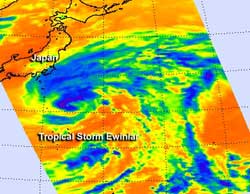NASA Sees Tropical Storm Ewiniar Embedded in Low Pressure

This infrared image was created from AIRS data of Tropical Storm Ewiniar on Sept. 27 at 0323 UTC as the storm nears eastern central Japan. The strongest thunderstorms with very cold cloud top temperatures appear in purple. Credit: NASA JPL/Ed Olsen<br>
As Tropical Storm Ewiniar continues to move northward it wound up in an elongated area of low pressure (called a trough) off Japan's east coast. The trough is bringing a strong westerly flow of air into Ewiniar.
Despite being battered by those winds, infrared data from the Atmospheric Infrared Sounder (AIRS) instrument that flies aboard NASA's Aqua satellite is showing that Ewiniar is managing to keep its tropical characteristics. AIRS data on Sept. 27 at 0323 UTC revealed that there is still strong thunderstorms in a band over the northern semi-circle, and weaker bands of thunderstorms around the rest of Ewiniar.
On Sept. 27 at 1500 UTC (11 a.m. EDT, Tropical Storm Ewiniar had maximum sustained winds near 55 knots (63.2 mph/102 kmh). It was located near 31.8 North and 141.9 East, about 265 nautical miles (305 miles/491 km) south-southeast of Tokyo, Japan. Ewiniar is moving to the north-northwest 6 knots (7 mph/11 kmh) and is expected to turn to the north-northeast over the next several days, taking it away from Japan.
Text credit: Rob Gutro
NASA's Goddard Space Flight Center, Greenbelt, Md.
Media Contact
All latest news from the category: Earth Sciences
Earth Sciences (also referred to as Geosciences), which deals with basic issues surrounding our planet, plays a vital role in the area of energy and raw materials supply.
Earth Sciences comprises subjects such as geology, geography, geological informatics, paleontology, mineralogy, petrography, crystallography, geophysics, geodesy, glaciology, cartography, photogrammetry, meteorology and seismology, early-warning systems, earthquake research and polar research.
Newest articles

Trotting robots reveal emergence of animal gait transitions
A four-legged robot trained with machine learning by EPFL researchers has learned to avoid falls by spontaneously switching between walking, trotting, and pronking – a milestone for roboticists as well…

Innovation promises to prevent power pole-top fires
Engineers in Australia have found a new way to make power-pole insulators resistant to fire and electrical sparking, promising to prevent dangerous pole-top fires and reduce blackouts. Pole-top fires pose…

Possible alternative to antibiotics produced by bacteria
Antibacterial substance from staphylococci discovered with new mechanism of action against natural competitors. Many bacteria produce substances to gain an advantage over competitors in their highly competitive natural environment. Researchers…





















